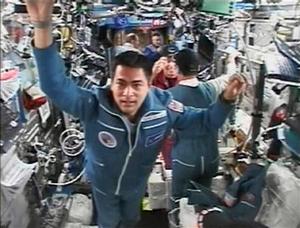A Russian capsule carrying a new crew for the International Space Station and Malaysia's first astronaut slipped into a berthing port at the orbital outpost on Friday as the space ships sailed 220 miles above Earth.

|
| ©REUTERS/NASA
|
| Spaceflight participant Sheikh Muszaphar Shukor of Malaysia floats inside the Destiny module of the International Space Station after arriving aboard the orbiting laboratory October 12, 2007 in this image from NASA TV.
|
The Soyuz spacecraft, which blasted off Wednesday from the Baikonur Cosmodrome in Kazakhstan, reached the station at 10:50 a.m. EDT/1450 GMT.
About 90 minutes later, hatches between the two vessels opened and NASA's Peggy Whitson, cosmonaut Yuri Malenchenko and Sheikh Muszaphar Shukor, an orthopedic surgeon and part-time model from Malaysia, floated aboard.
"Well, hello," one of the two Russian cosmonauts currently stationed on the outpost said through a translator. "Welcome on board."
Whitson and Malenchenko, both of whom have lived on the station previously, were to become the outpost's 16th crew and Whitson its first female commander.
The first from his nation to fly in space, Shukor was scheduled to remain aboard the station for eight days conducting medical research while Whitson and Malenchenko learn about station operations from the current crew.
"I'm feeling very well," Shukor said in a televised briefing with officials and guests gathered at the Russian Mission Control Center outside Moscow. "I have lots of American and Russian friends on board."
He then heard a familiar voice.
"This is your father. How are you doing?" Shukor's dad asked.
"Very well," Shukor replied. "I love you very much."
Shukor's flight is part of a commercial deal Russia cut to sell aircraft to Malaysia. He will return to Earth on October 21 with outgoing station commander Fyodor Yurchikhin and flight engineer Oleg Kotov.
The station, a $100 billion project of 16 nations, is a little more than 60 percent complete, with some of the most complex work still to come. Laboratory modules owned by the European and Japanese space agencies are scheduled to be installed in December and in 2008 respectively, as well as a Canadian-built robotic hand for the station's robot arm.
In addition, a European cargo ship called Jules Verne, a French author who pioneered the science fiction genre, is scheduled for a debut flight in February.
Three of the next visiting U.S. space shuttle crews will tackle initial tasks to install the new components, but it will be up to Whitson, Malenchenko and their third flight engineer to prepare for the additions and to complete the work.
"We're doing a lot more of the assembly operations," Whitson said in a preflight interview.
The new crew will not have much time to settle in before the first guests arrive.
Shuttle Discovery, set for launch on October 23, is expected to deliver a critical connection hub called Harmony to serve as a docking port for the new laboratories.
Whitson and Malenchenko start off their six-month mission with NASA astronaut Clay Anderson, already aboard the station, as their third crewmember.
Discovery astronaut Dan Tani will take over Anderson's slot until his replacement, France's Leopold Eyharts, arrives on a shuttle flight in December.

Reader Comments
to our Newsletter